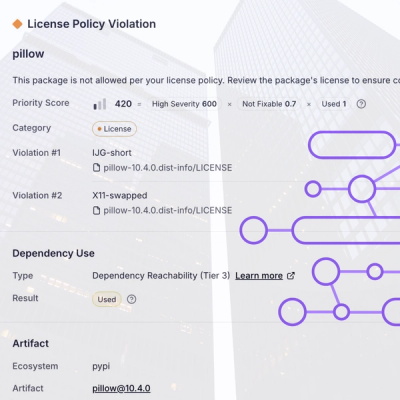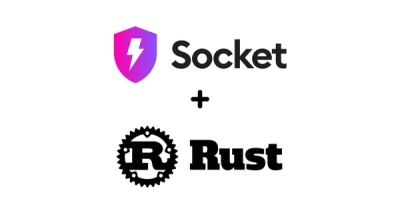
Research
/Security News
Critical Vulnerability in NestJS Devtools: Localhost RCE via Sandbox Escape
A flawed sandbox in @nestjs/devtools-integration lets attackers run code on your machine via CSRF, leading to full Remote Code Execution (RCE).
react-draggable
Advanced tools
The react-draggable npm package allows React components to be draggable within the DOM. It provides a simple way to make elements draggable and offers various customization options such as grid snapping, axis locking, and event handling for drag actions.
Basic Dragging
This code snippet enables basic dragging functionality for the enclosed <div> element.
{"<Draggable><div>I can be dragged</div></Draggable>"}Controlled Draggable
This example shows a controlled component where the position is managed by the component's state, allowing for more complex interactions.
{"<Draggable position={this.state.position} onDrag={this.handleDrag}><div>I can be dragged</div></Draggable>"}Axis Constraints
This code restricts the dragging movement to the horizontal axis.
{"<Draggable axis='x'><div>I can only be dragged horizontally</div></Draggable>"}Grid Snapping
This snippet makes the element snap to a grid pattern as it's being dragged.
{"<Draggable grid={[25, 25]}><div>I snap to a 25x25 grid</div></Draggable>"}Bounds Limitation
This code ensures that the draggable element cannot be moved outside the bounds of its parent container.
{"<Draggable bounds='parent'><div>I can't be dragged outside my parent</div></Draggable>"}This package provides a higher level of abstraction for creating draggable and droppable interfaces, focusing on vertical and horizontal lists. It's more suitable for complex drag-and-drop interfaces, compared to react-draggable which is more low-level.
React DnD is a set of React utilities to help you build complex drag and drop interfaces while keeping your components decoupled. It is more comprehensive than react-draggable and uses the HTML5 drag and drop API.
This package provides components and higher-order components to make elements sortable via drag-and-drop. It's specifically designed for creating sortable lists and grids, unlike react-draggable which is for general-purpose dragging.
React Grid Layout is a grid layout system much like Packery or Gridster, for React. It allows users to create draggable and resizable layouts. It's more specialized for layout management compared to react-draggable which is for dragging elements.

A simple component for making elements draggable.
<Draggable>
<div>I can now be moved around!</div>
</Draggable>
$ npm install react-draggable
If you aren't using browserify/webpack, a
UMD version of react-draggable is available. It is updated per-release only.
This bundle is also what is loaded when installing from npm. It expects external React and ReactDOM.
If you want a UMD version of the latest master revision, you can generate it yourself from master by cloning this
repository and running $ make. This will create umd dist files in the dist/ folder.
The default export is <Draggable>. At the .DraggableCore property is <DraggableCore>.
Here's how to use it:
// ES6
import Draggable from 'react-draggable'; // The default
import {DraggableCore} from 'react-draggable'; // <DraggableCore>
import Draggable, {DraggableCore} from 'react-draggable'; // Both at the same time
// CommonJS
let Draggable = require('react-draggable');
let DraggableCore = Draggable.DraggableCore;
<Draggable>A <Draggable> element wraps an existing element and extends it with new event handlers and styles.
It does not create a wrapper element in the DOM.
Draggable items are moved using CSS Transforms. This allows items to be dragged regardless of their current positioning (relative, absolute, or static). Elements can also be moved between drags without incident.
If the item you are dragging already has a CSS Transform applied, it will be overwritten by <Draggable>. Use
an intermediate wrapper (<Draggable><span>...</span></Draggable>) in this case.
View the Demo and its source for more.
import React from 'react');
import ReactDOM from 'react-dom';
import Draggable from 'react-draggable';
class App extends React.Element {
eventLogger = (e: MouseEvent, data: Object) => {
console.log('Event: ', event);
console.log('Data: ', data);
};
render() {
return (
<Draggable
axis="x"
handle=".handle"
defaultPosition={{x: 0, y: 0}}
position={null}
grid={[25, 25]}
zIndex={100}
onStart={this.handleStart}
onDrag={this.handleDrag}
onStop={this.handleStop}>
<div>
<div className="handle">Drag from here</div>
<div>This readme is really dragging on...</div>
</div>
</Draggable>
);
}
}
ReactDOM.render(<App/>, document.body);
The <Draggable/> component transparently adds draggability to its children.
Note: Only a single child is allowed or an Error will be thrown.
For the <Draggable/> component to correctly attach itself to its child, the child element must provide support
for the following props:
style is used to give the transform css to the child.className is used to apply the proper classes to the object being dragged.onMouseDown, onMouseUp, onTouchStart, and onTouchEnd are used to keep track of dragging state.React.DOM elements support the above properties by default, so you may use those elements as children without any changes. If you wish to use a React component you created, you'll need to be sure to transfer prop.
<Draggable> Props://
// Types:
//
type DraggableEventHandler = (e: Event, data: DraggableData) => void | false;
type DraggableData = {
node: HTMLElement,
// lastX + deltaX === x
x: number, y: number,
deltaX: number, deltaY: number,
lastX: number, lastY: number
};
//
// Props:
//
{
// If set to `true`, will allow dragging on non left-button clicks.
allowAnyClick: boolean,
// Determines which axis the draggable can move. This only affects
// flushing to the DOM. Callbacks will still include all values.
// Accepted values:
// - `both` allows movement horizontally and vertically (default).
// - `x` limits movement to horizontal axis.
// - `y` limits movement to vertical axis.
// - 'none' stops all movement.
axis: string,
// Specifies movement boundaries. Accepted values:
// - `parent` restricts movement within the node's offsetParent
// (nearest node with position relative or absolute), or
// - An object with `left, top, right, and bottom` properties.
// These indicate how far in each direction the draggable
// can be moved.
bounds: {left: number, top: number, right: number, bottom: number} | string,
// Specifies a selector to be used to prevent drag initialization.
// Example: '.body'
cancel: string,
// Specifies the `x` and `y` that the dragged item should start at.
// This is generally not necessary to use (you can use absolute or relative
// positioning of the child directly), but can be helpful for uniformity in
// your callbacks and with css transforms.
defaultPosition: {x: number, y: number},
// If true, will not call any drag handlers.
disabled: boolean,
// Specifies the x and y that dragging should snap to.
grid: [number, number],
// Specifies a selector to be used as the handle that initiates drag.
// Example: '.handle'
handle: string,
// Called whenever the user mouses down. Called regardless of handle or
// disabled status.
onMouseDown: (e: MouseEvent) => void,
// Called when dragging starts. If `false` is returned any handler,
// the action will cancel.
onStart: DraggableEventHandler,
// Called while dragging.
onDrag: DraggableEventHandler,
// Called when dragging stops.
onStop: DraggableEventHandler,
// Much like React form elements, if this property is present, the item
// becomes 'controlled' and is not responsive to user input. Use `position`
// if you need to have direct control of the element.
position: {x: number, y: number}
}
Note that sending className, style, or transform as properties will error - set them on the child element
directly.
<Draggable> is a 'batteries-included' component that manages its own state. If you want to completely
control the lifecycle of the component, use <DraggableCore>.
For some users, they may want the nice state management that <Draggable> provides, but occasionally want
to programmatically reposition their components. <Draggable> allows this customization via a system that
is similar to how React handles form components.
If the prop position: {x: number, y: number} is defined, the <Draggable> will ignore its internal state and use
the provided position instead. Altneratively, you can seed the position using defaultPosition. Technically, since
<Draggable> works only on position deltas, you could also seed the initial position using CSS top/left.
We make one modification to the React philosophy here - we still allow dragging while a component is controlled.
We then expect you to use at least an onDrag or onStop handler to synchronize state.
To disable dragging while controlled, send the prop disabled={true} - at this point the <Draggable> will operate
like a completely static component.
<DraggableCore>For users that require absolute control, a <DraggableCore> element is available. This is useful as an abstraction
over touch and mouse events, but with full control. <DraggableCore> has no internal state.
See React-Resizable and React-Grid-Layout for some usage examples.
<DraggableCore> is a useful building block for other libraries that simply want to abstract browser-specific
quirks and receive callbacks when a user attempts to move an element. It does not set styles or transforms
on itself and thus must have callbacks attached to be useful.
<DraggableCore> takes a limited subset of options:
{
allowAnyClick: boolean,
cancel: string,
disabled: boolean,
enableUserSelectHack: boolean,
grid: [number, number],
handle: string,
onStart: DraggableEventHandler,
onDrag: DraggableEventHandler,
onStop: DraggableEventHandler
onMouseDown: (e: MouseEvent) => void
}
Note that there is no start position. <DraggableCore> simply calls drag handlers with the below parameters,
indicating its position (as inferred from the underlying MouseEvent) and deltas. It is up to the parent
to set actual positions on <DraggableCore>.
Drag callbacks (onStart, onDrag, onStop) are called with the same arguments as <Draggable>.
$ npm run dev$ npm testmake release-patch, make release-minor, or make-release-majormake publishMIT
2.0.0-beta3 (Apr 19, 2016)
FAQs
React draggable component
The npm package react-draggable receives a total of 2,882,206 weekly downloads. As such, react-draggable popularity was classified as popular.
We found that react-draggable demonstrated a healthy version release cadence and project activity because the last version was released less than a year ago. It has 2 open source maintainers collaborating on the project.
Did you know?

Socket for GitHub automatically highlights issues in each pull request and monitors the health of all your open source dependencies. Discover the contents of your packages and block harmful activity before you install or update your dependencies.

Research
/Security News
A flawed sandbox in @nestjs/devtools-integration lets attackers run code on your machine via CSRF, leading to full Remote Code Execution (RCE).

Product
Customize license detection with Socket’s new license overlays: gain control, reduce noise, and handle edge cases with precision.

Product
Socket now supports Rust and Cargo, offering package search for all users and experimental SBOM generation for enterprise projects.